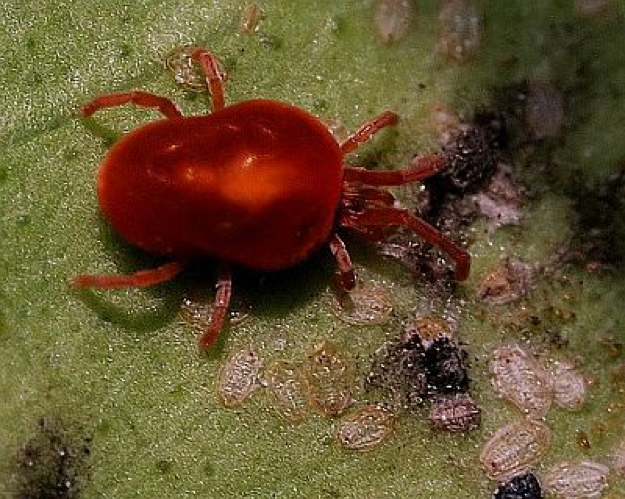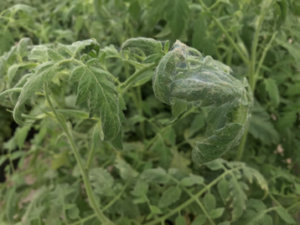The Red Spider Mite – also known as the ‘Two Spotted Spider Mite’ – is one of those greenhouse pests that can be quite common on tomatoes grown under protection. Unfortunately it can also prove quite difficult to control.
Like the whitefly this is another fast-colonising pest usually found on protected crops. The red spider mite is a tiny wingless insect – up to about 1 mm long – with eight legs and a one-piece body. Young and adult mites feed on the leaves extracting sap and soft plant cells.

Signs of Infestation
The first sign of a red spider mite infestation are either small spider webs – often high up on the plant – or white speckling on the upper surface of the leaves. As the attack progresses, they take on a bronzed appearance and may wither and die. Fine webbing is produced, strung between parts of the plant or under the leaves.
Detection of Red Spider Mite on Greenhouse Tomatoes
Using a magnifying glass the red spider mite and their eggs can be seen on the undersides of the leaves. In an unheated greenhouse the worst attacks occur from December to March, but red spider mites can be active year round. Serious damage to the plant is only done when population numbers dramatically increase resulting in leaf, flower and even fruit loss.
Infamous Species
Of the dozens of different plant parasites which may plague tomatoes in a greenhouse, one of the most infamous, talked about, and feared is Tetranychida urtica — more commonly known as the two-spotted spider mite, or red spider mite. As luck would have it, these arachnids are also among the most common pests in indoor gardens. They are found everywhere. Native to Eurasia, they can now be found worldwide, particularly in controlled agriculture settings.
Impact and Spread
Although the mites’ initial assault may seem innocuous, their tiny size and ability to reproduce very quickly compounds the issue. As the pests themselves are difficult to spot, a grower can easily miss the subtle signs of initial infestation if he or she does not closely inspect their greenhouse each day. A less vigilant grower might overlook these signs until leaves are already yellowing, dying and dropping off and the plants are covered in highways of webbing, not to mention hundreds or thousands of very mobile, very hungry mites.

Prevention and Control
Since we understand that spider mites are common, elusive, and destructive, the question arises, how do you get rid of spider mites? Or better yet, how do one prevent spider mites from infiltrating greenhouses in the first place? If you are diligent about prevention, eradication may not be necessary.
Mites are generally brought into the greenhouse by none other than the workers. Mites can ride in on clothing, hair, or any outdoor materials you bring in with you. For this reason, it is important to ensure that clothes, hands, hair, etc. are clean before entering the greenhouse – better still, to wear hygienic greenhouse apparel.
It is also important to know that mites can lie dormant when conditions are unfavourable, only to re-emerge when they think they may have a better chance at survival. When receiving any new seedlings, keep them in a separate quarantine area for the first week or two. This will keep any pests away from your greenhouse while you watch carefully for their appearance on your new seedlings. Check daily for any signs of pests like those shown in the image and treat if necessary.
In a perfect world, we would never have to treat for mites. Many of the greenhouse operators we talk to are currently fighting a mite population (again), or recently were. Most, if not all, have at one point or another.

Insecticide Use
There are many sprays marketed mainly or solely for the eradication of mites. An insecticide (or biological control for optimum health purposes) for resistance management, would be a suspension concentrate acaricide and insecticide for the control of red spider mites and whiteflies in tomatoes.
Delay insecticide resistance.
Avoid exclusive repeated use of insecticides from the same insect group code. Alternate or tank mix with products from different insecticide group codes. Integrate other control methods (chemical, cultural, biological) into insect control programs. For specific information on resistance management contact the registration holder of this product.
An anti-resistance strategy in agricultural pests is very important. Use alternative products for the control of red spider mite and sucking pests in those areas where the cotton aphid has not yet developed resistance to organophosphates.
Importance of Scouting
Make use of a scouting system and economic threshold values to determine when to commence application of a insecticide for insect and mite control in tomatoes. Regular and a controlled scouting program will ensure the producer can act at the first sighting of red spider mite on his tomatoes and therefore save his entire crop.
Spraying Techniques
When spraying, make sure to wet the entire plant. Do not overdose by overlapping applications or by exceeding the recommended rate. Avoid spraying during the heat of the day or if foliage is wet. Allow 24 hours to expire between application and overhead irrigation.
Conclusion
It cannot be reiterated enough that prevention is better than cure. Also, should it be necessary to use insecticides to save the crop, especially in a controlled environment like a greenhouse, the assistants should be protected against the remotest form of poisoning.

